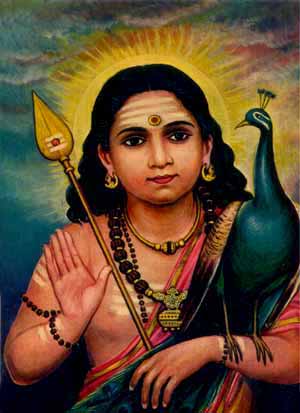|
| |||||||||||||
 
The Worship of Muruga"Muruga! Muruga! Om Muruga!" cry out in ecstacy the young and the old, the rich and the poor, the learned and the ignorant, the fashionable and the not-so-fashionable, the saintly and the sinful gathered at Nallur. The cry goes out from the heart though it may not always come out from the month. Such is invariably the scene at all the places sacred to Śrī Murugan. Aloofness and reticence, pride and poop, status and position are forgotten and people freely abandon themselves to the bliss of self-forgetfulness and the tenderly loving or wildly intoxicating dwelling on of the glorious aspects of Lord Muruga. Childhood innocence, love, beauty, youth, heroism in war are qualities that hold in thrall the worldly minded, those enamoured of the world of form and name, just as Truth and Wisdom (and bliss from contemplation of these) are the sole aim and reason for existence of those seeking to peer into the Beyond, the Kingdom of Eternity. And yet Śrī Muruga combines all these apparently conflicting aims, granting to His devotees what ever gifts they ask of Him. All power and strength are vouch safed to those who pray to Him. He is the "Su-brahm" - the self, the Lord of all the seen and unseen world, which draw their life, move and have their being in Him. His is all the power of action, the Kriya Sakti. His are all the desires, (noble and to us ignoble), as evinced through the numerous living entities, the Ichcha Sakti: His seat is all these multi-coloured world of matter, of form His is the lance (the Vel) like wisdom, which pierces through this mountain of colossal ignorance and delusion surrounding us. and destroying the hosts of demons (asuras) that hold us in bondage, finally severing into two the master demon, the sense of a separate personality—the feeling of the I which has ever held us captive, denying us the whole, the all, he is the Lord without a compeer, the Spirit Eternal, the Paramatman whom the poor mind (subtle matter though it be) can never, never comprehend. The mind may take us part of way help in discriminating a little, but stops after a little while, because Spirit alone, rid of separateness through love, can know Spirit. And then there is no knowing or non-knowing. So the sages, their holy utterances and the scriptures tell us. One thing we know for certain. At these holy places, sacred to Murugan, we are no more bothered above hearing arguments about it and about. We don't come out by the same door as in we went. We come away with an experience irrefutable by any logic. We know we are possessed by an awareness, which rises above our everyday petty selves. It is not mass-hysteria, dragging people down to acts of crime or atrocities. It is an electrification on a mass scale, making everyone bigger and larger, making them forget their bodies and the small people around them (perhaps dimly perceived in some and more pronounced in others). We don't know how these holy places have always attracted men, making available to common people directly or indirectly their holy thoughts, cleansing their hearts and clarifying their thoughts. "Ask, and it shall be given." These holy words were not said in vain. Ask Śrī Muruga, the Holy Self enshrined and worshipped there in the temple, the Holy Self that in its loving grace inexpressible came in the form of the Guru, ask him and it shall be given. The worldly minded ask for boons of the world. They get them all with their attendant cares and sorrows, because decay and dissolution are part of the nature of these things. Ask for the gift of ever-remembering his Holy Feet (‘Feet' and such expressions though not appropriate have still to be used for purpose of intelligibility) for the gift of not asking because in asking there comes the sense of separation, of inadequate love, of being other than the Holy self. Yet for the bliss of worship, sages and saints have likened the Holy self to a child, to a youth, to a young Commander-in-Chief in battle against the hordes of darkness, to a grand ascetic (andi), who has set at nought all these things that the poor world runs after caring not to whom all the worlds runs after, caring not to whom all the worlds, that are and to come, belong, as the passionate lover who comes seeking the lowly maiden Valli (you, myself) living with our savage (Veddah) kinsmen, the senses, to the lance (vel) itself the lance of wisdom that cleaves through and destroys darkness, and in sheer helplessness (in portraying that which is without form) to the empty Void (akasa) as at Kataragama, (where a box is also carried at festivals said to contain a yantra and thus more satisfying to many people). Hence the universal cry, "Om Muruga, Om Muruga" to the great self who grants Bhoga and Yoga, making all his devotees finally emerge in himself, the bliss which sages tell us we can enter but never describe or comprehend. Om Muruga Om! from The Sivathondan of August-September 2003Kataragama according to an old Indian print
| |||||||||||||
![Kataragama according to an old Indian print [47 kb]](pix/old-kataragama-print980.gif)